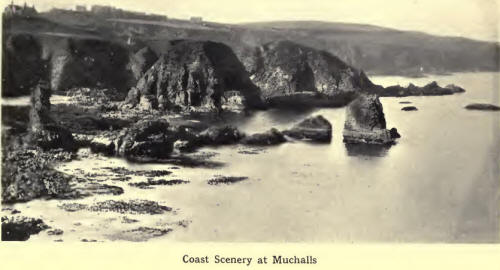Kincardine, like its
southern neighbour Forfarshire, of which it is indeed but a
continuation, exhibits a good epitome of typical Scottish .scenery. The
two counties present pretty much the same physical appearance. Each, in
a restricted though real sense, may be termed
“Land of brown heath and
shaggy wood,
Land of the mountain and the flood.”
They both show a fertile
tract of level or gently undulating land along the coast, dotted here
and there with green plantation, stately mansion, or comfortable-looking
homestead. In both counties, also, the interior is well sheltered from
the biting east winds that sweep in from the sea by a range of hills
running parallel to the coast—the Sidlaw Hills in Forfarshire, and the
Garvock Heights in the Mearns. Similarly, on the north side of each, the
Grampians rising in majestic grandeur form a wall of protection from the
cold northern blasts. In both, we thus have favourable conditions for
the production of fertile soil through the disintegration of the rocks
and stones on the hillsides, and through the age-long washing down by
rain and flood of new soil from the “ everlasting hills ” into the
valleys below. For the sportsman the hills and moors of Kincardineshire
provide grouse and other game. The parish of Strachan contains the one
deer forest in the county—the most easterly deer forest in Scotland.
The highly picturesque scenery along the coast of Kincardineshire is a
never-ending delight to the artist and to other lovers of nature ; while
in its diversified flora, its rock structures, its antiquities, the
county offers ample material to botanist, geologist, and archgeologist.

Kincardineshire has long
been connected with the fishing industry, but the introduction of steam
trawlers and drifters has, to a large extent, displaced the line fishing
which was successfully pursued from the many villages and creeks along
the coast. Manufactures can hardly be said to exist in the county. With
the decay of handloom weaving, the manufacture of linens and woollens
was transferred to the larger centres in the south and north—Dundee and
Aberdeen. On the outskirts of the Forfarshire linen-manufacturing area,
and connected with Dundee as the principal market-centre, there are,
however, flourishing spinning mills at Bervie, Gourdon, and Johnshaven.
The county is intersected by the main line of the Caledonian Railway,
which, at least for part of its distance, runs near to the route of the
old roads, a fact which indicates the limitations imposed by nature both
on the ancient makers of roads and the modern makers of railways. The
position of many of the towns and villages is along this natural route.
A similar explanation applies to the position of the towns and villages
along the coast and in the Dee valley. With the exception, however, of
Stonehaven and Banchory, their size has not yet greatly increased under
the influence of railways, as in other parts of the country.
Although at one time possessed of a royal residence, Kincardineshire
cannot be called a county of much national importance. On the other
hand, few districts have afforded such an interesting field for the
study of local history or research into manners and customs of the past.
The county has a world-wide reputation as a sanatorium centre, while
Stonehaven with its bracing air, its woods, walks, and scenes of beauty,
and its unique opportunities for healthy recreation and enjoyment,
attracts visitors from all parts of Britain during the summer months.
|

